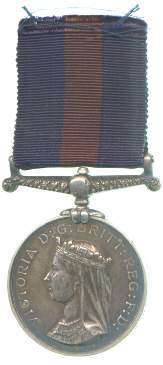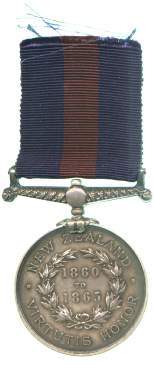Current Location: In storage
Maker(s)
Mint:
London
Die-engraver:
Austin, G.
Artist:
Wyon, Joseph Shepherd
Ruler:
Victoria (1837-1901)
Ruler:
Victoria D: G: Britt: Reg: F: D:
(With the title of)
Entities
Categories
Description
The New Zealand Medal was instituted in 1869 to recognise service in the New Zealand Wars of 1845-46, 1847 and 1860-66, and not for any of the other conflicts in that or a wider period in the islands. The phrase New Zealand Wars covers a variety of affrays, whose common factors were relatively few beyond that all, at some level, involved government forces suppressing risings by the indigenous Maori peoples. The background to the conflicts was misunderstandings and lapses, more or less wilful from case to case, in the implementation of the Treaty of Waitangi by which in 1840 the newly-instituted New Zealand government had protected the Maori tribes from loss of their lands. Not all the conflicts for which the New Zealand Medal was awarded were of this kind, however, some rather being wars between Maori tribes in which one side had managed to engage the government.
There were twenty-eight different sorts of New Zealand Medal awarded, of which twenty-seven bore the dates of different periods of service, some of which overlapped or enveloped the periods of other issues. There was also an undated medal issued for those whose service dates were no longer recorded, which might serve for any of the other twenty-seven.
The dates on this medal relate to a series of conflicts, of which the first was that known as the First Taranaki War, which arose over a disputed sale of Maori land at Waitara. Occupation of the disputed area by British forces in March 1860 resulted in a number of inconclusive engagements in which the British generally took higher casualties than the Maoris, whose night-built brush and earth fortifications proved effectively invulnerable to British artillery fire. After a brief truce in June, Maori fighting became more serious and inflicted heavy losses on the British. While it was clear that the Maori could be repulsed in frontal assaults, for this very reason they relied on sieges and ambushes in which their tactics proved considerably more effective. By March 1861 the British had made little ground, and a senior Maori chief from a centralising party then orchestrated a ceasefire. The disputed land was occupied by the Maori and eventually retroceded, for a short while.
The Colonial Government in New Zealand recognised the danger to their situation and ambitions posed by the new centralisation of the Maori under what was known as the King Movement, led by King Tawhiao of the Tainui tribe. By 1863 sufficient forces had been assembled to carry out a definitive assault on the confederacy's lands, the Waikato, and this proceeded slowly, with the same mixed results as the 1861 campaign, and considerable dissatisfaction on the part of the British officer commanding, General Sir Duncan Cameron, who saw the campaign as a use of British troops to steal Maori land to enrich the New Zealand government. The Maoris could afford their losses less easily than the British, however, and by 1864, despite considerable aid from other tribes, the Waikato chiefs were forced to a last stand at Orakau. The British massacred some of the defenders but many escaped and events elsewhere in New Zealand led the British to agree a cease-fire. The King Movement remained effectively undefeated.
The events that led to the Waikato ceasefire were attacks on British forces at Tauranga in the North Island, where they had been sent to deter the support coming thence to the Waikato. Here again, and this time despite opposition to their enemies from other Maori tribes, large numbers of British forces were repeatedly defeated by small numbers of Maoris using ambush tactics and highly effective bush fortresses (Pas). One decisive British victory in the field at Te Ranga allowed negotiations to be opened and the British then withdrew most of their troops to the South Island where fighting had now broken out at Wanganui in what would be the Second Taranaki War.
This conflict was distinguished from the still-ongoing fighting of previous wars by the new presence of the religious movement known as the Pai Marire, or, when taken to the battlefield against the wishes of their pacifist prophet Te Ua, the Hau Hau. Although their early beliefs of invulnerability were quickly dashed, the new mass attacks they adopted (often resisted by non-believing Maori as much as colonialists) presented a worrying threat. Governmental response to this was fragmented, as Cameron and his men, backed by the British government in London, were resistant to what they increasingly saw as a land-grab despite the urging of their superiors in Auckland. Fighting continued desultorily through 1865, with the British military only committing to battle when they had either a manifestly superior position or Maori support; the war would eventually peter out in 1866 amid considerable political discord over its future.
This medal was awarded to Private William Cotter of the 65th Foot. Lester Watson purchased the medal from the dealer Lowe at some point before 1928.
Notes
History note: Gift of L. Hoyt Watson; ex Lester Watson Collection, bt Lowe before 1928
Legal notes
Given by Lester Watson through Cambridge in America, 2009
Measurements and weight
Diameter: 36.1 mm
Weight: 37.26 g
Place(s) associated
Acquisition and important dates
Method of acquisition: Given
(2009)
by
Watson, Lester
Dating
Production date:
AD 1869
Materials used in production
Silver
Techniques used in production
Struck
Inscription or legends present
Inscription present: Bust of Victoria facing left with veil
- Text: VICTORIA D: G: BRITT: REG: D: F:
- Location: Obverse
- Type: Design
Inscription present: Central inscription "1860 to 1865" within laurel wreath
- Location: Reverse
- Type: Design
References and bibliographic entries
Identification numbers
Accession number: CM.1399-2009
Primary reference Number: 141493
Watson Catalogue: 308
Ordering: M-0282
Previous object number: LW.0282
Stable URI
Audit data
Created: Saturday 6 August 2011
Updated: Monday 15 January 2024
Last processed: Monday 15 January 2024
Associated departments & institutions
Owner or interested party:
The Fitzwilliam Museum
Associated department:
Coins and Medals





